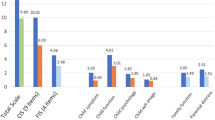Abstract
Aim: The aim of the present study was firstly to assess the persistence of pain-related behaviours of the Dental Discomfort Questionnaire (DDQ) and secondly to complete a follow-up study to assess the effect of dental treatment on pain-related behaviours in preschool children. Methods: The 9-question DDQ instrument was used to assess toothache-related behaviours in a group of preverbal children. The test-retest analysis questionnaire was filled out twice by 44 parents on behalf of their referred child. The follow-up study questionnaire was filled out by 71 parents before and after all dental disease was treated. Results: A strong correlation for the test-retest was found over a 2 month period before treatment. When the behaviour items were compared independently before and after treatment it appeared that after treatment all but one behaviour (i.e. bites with molars instead of teeth) was displayed less often. Overall, after treatment all children had a lower mean DDQ score. Conclusions: Dental treatment of children leads to reduced toothache-related behaviours and subsequently to a better quality of life. The DDQ is a sensitive instrument to measure dental discomfort before and after restorative treatment if and when the follow-up period is short. The DDQ can possibly support healthcare providers, teachers and parents in their assessment of toothache in young children.
Similar content being viewed by others

References
Almeida AG, Roseman MM, Sheff M, Huntington N, Huges CV. Future caries susceptibility in children with early childhood caries following treatment under general anaesthesia. Pediatr Dent 2000;22:302–306.
Anderson HK, Drummond BK, Thomson WM. Changes in aspects of children’s oral-health-related quality of life following dental treatment under general anaesthesia. Int J Paediatr Dent 2004;14:317–325.
Chase I, Berkowitz RJ, Mundorff-Shrestha SA, et al. Clinical outcomes for early childhood caries (ECC): the influence of salivary mutans streptococci levels. Eur J Paediatr Dent 2004;3:143–146.
Eidelman E, Faibis S, Peretz B. A comparison of restorations for children with early childhood caries treated under general anaesthesia or conscious sedation. Pediatr Dent 2000;22:33–37.
Howard RF. Current status of pain management in children. J Americ Med Assoc 2003;290:2464–9.
Kalsbeek H, Verrips GH, Eijkman MA, Kieft JA. Changes in caries prevalence in children and young adults of Dutch and Turkish or Moroccan origin in the Netherlands between 1987 and 1993. Caries Res 1996;30:334–341.
Low W, Tan S, Schwartz S. The effects of severe caries on the quality of life in young children. Pediatr Dent 1999;21:325–326.
Pitts NB, Boyles J, Nugent ZJ, Thomas N, Pine CM. British Association for the Study of Community Dentistry. The dental caries experience of 5-year-old children in England and Wales (2003/4) and in Scotland (2002/3). Surveys coordinated by the British Association for the Study of Community Dentistry. Community Dent Health 2005;22:46–56.
Sheehy E, Hirayama K, Tsamtsouris A. A survey of parents whose children had full-mouth rehabilitation under general anaesthesia regarding subsequent preventive dental care. Pediatr Dent 1994;16:362–364.
Thomas CW, Primosch RE. Changes in incremental weight and well being of children with rampant caries following complete dental rehabilitation. Pediatr Dent 2002;24:109–113.
Vargas CM, Crall JJ, Schneider DA. Sociodemographic distribution of pediatric dental caries: NHANES III, 1988–1994. J Amer Dent Assoc 1998;129:1229–1238.
Versloot J, Veerkamp JS, Hoogstraten J. Dental Discomfort Questionnaire for young children before and after treatment. Acta Odontol Scand 2005;63:367–370.
Versloot J, Veerkamp JS, Hoogstraten J. Dental Discomfort Questionnaire: assessment of dental discomfort and/or pain in very young children. Comm Dent Oral Epidemiol 2006;34:47–52.
White H, Lee JY, Vann WF. Parental evaluation of quality of life measures following pediatric dental treatment using general anaesthesia. Anesth Prog 2003;50:105–110.
Author information
Authors and Affiliations
Corresponding author
Rights and permissions
About this article
Cite this article
Versloot, J., Veerkamp, J.S.J. & Hoogstraten, J. Dental Discomfort Questionnaire for young children following full mouth rehabilitation under general anaesthesia: a Follow-up report. Eur Arch Paediatr Dent 7, 126–129 (2006). https://doi.org/10.1007/BF03262552
Published:
Issue Date:
DOI: https://doi.org/10.1007/BF03262552


